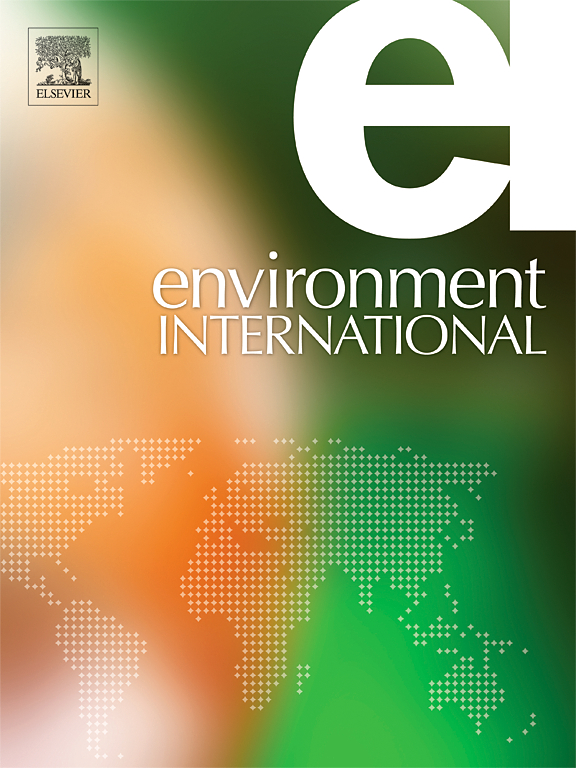Global, regional, and national burden of neonatal diseases attributable to fine particulate matter air pollution, 1990–2050
IF 10.3
1区 环境科学与生态学
Q1 ENVIRONMENTAL SCIENCES
引用次数: 0
Abstract
Fine particulate matter (PM2.5) air pollution constitutes a significant hazard to the well-being and survival of children everywhere, posing particularly dire risks to neonates. However, the neonatal disease burden attributable to PM2.5 pollution remains unclear worldwide. Data on neonatal diseases attributable to PM2.5 pollution were obtained and collected from the Global Burden of Disease Study (GBD) 2021. The main outcome was the age-standardized disability-adjusted life-years (DALYs) rate (ASDR) and age-standardized mortality rate (ASMR) per 100 000 population of neonatal diseases caused by PM2.5 pollution. These metrics were stratified by sex, region, country, and disease. The correlations, trends, and projections of the burden were also analyzed. Globally, there were approximately 497.0 thousand deaths and 44737.3 thousand DALYs from neonatal diseases caused by PM2.5 pollution in 2021. From 1990 to 2021, the overall ASDR (1120.4 to 723.1) and ASMR (12.5 to 8.0) showed a downward trend. However, the ASDR of neonatal diseases attributable to PM2.5 pollution was high in Sub-Saharan Africa (1717.1 to 1235.8) and South Asia (2010.4 to 1148.1), especially regarding household PM2.5 pollution. The higher ASDR attributable to PM2.5 pollution was observed in neonatal encephalopathy due to birth asphyxia and trauma and neonatal preterm birth. By 2050, the ASDR of neonatal disease impacts from household PM2.5 pollution remain persistently high. Neonatal disease burden attributable to PM2.5 pollution remains a crucial health issue in children. Targeted strategies to improve PM2.5 air quality and neonatal disease burden are essential.


1990-2050年细颗粒物空气污染造成的全球、区域和国家新生儿疾病负担
细颗粒物(PM2.5)空气污染对世界各地儿童的福祉和生存构成重大危害,对新生儿构成特别严重的风险。然而,PM2.5污染造成的新生儿疾病负担在全球范围内仍不清楚。PM2.5污染导致的新生儿疾病数据来自2021年全球疾病负担研究(GBD)。主要结局是PM2.5污染引起的新生儿疾病的年龄标准化残疾调整生命年(DALYs)率(ASDR)和每10万人口年龄标准化死亡率(ASMR)。这些指标按性别、地区、国家和疾病分层。还分析了负担的相关性、趋势和预测。2021年,全球约有49.7万人死于PM2.5污染引起的新生儿疾病,44737.3万人死于DALYs。1990 - 2021年,总体ASDR(1120.4 ~ 723.1)和ASMR(12.5 ~ 8.0)呈下降趋势。然而,PM2.5污染导致的新生儿疾病的ASDR在撒哈拉以南非洲(1717.1 ~ 1235.8)和南亚(2010.4 ~ 1148.1)较高,尤其是在家庭PM2.5污染方面。PM2.5污染导致的新生儿脑病ASDR较高见于出生窒息和创伤及新生儿早产。到2050年,家庭PM2.5污染对新生儿疾病影响的ASDR仍居高不下。可归因于PM2.5污染的新生儿疾病负担仍然是儿童的一个关键健康问题。改善PM2.5空气质量和新生儿疾病负担的有针对性战略至关重要。
本文章由计算机程序翻译,如有差异,请以英文原文为准。
求助全文
约1分钟内获得全文
求助全文
来源期刊

Environment International
环境科学-环境科学
CiteScore
21.90
自引率
3.40%
发文量
734
审稿时长
2.8 months
期刊介绍:
Environmental Health publishes manuscripts focusing on critical aspects of environmental and occupational medicine, including studies in toxicology and epidemiology, to illuminate the human health implications of exposure to environmental hazards. The journal adopts an open-access model and practices open peer review.
It caters to scientists and practitioners across all environmental science domains, directly or indirectly impacting human health and well-being. With a commitment to enhancing the prevention of environmentally-related health risks, Environmental Health serves as a public health journal for the community and scientists engaged in matters of public health significance concerning the environment.
 求助内容:
求助内容: 应助结果提醒方式:
应助结果提醒方式:


